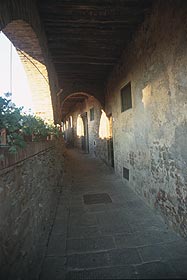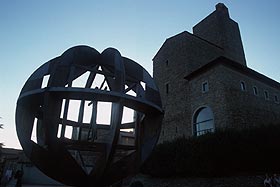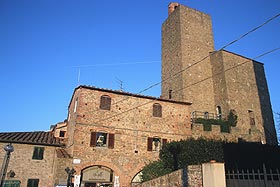Conti Guidi Castle - Vinci
The
Conti Guidi Castle dominates the historical center of Vinci,
is reacheable following the motorway FI-PI-LI, exit at 'Empoli Ovest'
and from here following the road signs.
 Vinci
rises at the southern slopes of the Montalbano mountain. The Castle,
with its imposing
structure, dominates the entire territory and great part
of the Lower Valdarno. The first
notices that regard it date the year 1164, its name is written on a diploma
emitted by Frederick Barbarossa. Thanks to this document we can be
sure that the castle was
the first
building to rise on site (together with a now disappeared parish church).
However the origin of the 'castrum' of Vinci seems to go back to the
High Middle Ages, when the Counts Guidi decided to construct here their
fortified residence to expand their feudal power on this zone,
important also for the interests
of Florence, Pisa, Lucca and Pistoia. Vinci
rises at the southern slopes of the Montalbano mountain. The Castle,
with its imposing
structure, dominates the entire territory and great part
of the Lower Valdarno. The first
notices that regard it date the year 1164, its name is written on a diploma
emitted by Frederick Barbarossa. Thanks to this document we can be
sure that the castle was
the first
building to rise on site (together with a now disappeared parish church).
However the origin of the 'castrum' of Vinci seems to go back to the
High Middle Ages, when the Counts Guidi decided to construct here their
fortified residence to expand their feudal power on this zone,
important also for the interests
of Florence, Pisa, Lucca and Pistoia.
 The relations between the City-State of Florence and the Guidi
were not always good. Between the 12°
and 13° century the power of the feudal Family declined until the
1254 when they yield the castle to Florence spontaneously: the
sale
contract was signed the 12th August and
Vinci became part of the Florentine peasantry. The relations between the City-State of Florence and the Guidi
were not always good. Between the 12°
and 13° century the power of the feudal Family declined until the
1254 when they yield the castle to Florence spontaneously: the
sale
contract was signed the 12th August and
Vinci became part of the Florentine peasantry.
In 1315 the native population rebelled, helped by
soldiers of Uguccione of the Faggiola coming from Pisa and Lucca,
but after alternate vicissitudes the Florentine
reconquered
Vinci and since the 1318 they start sending a constable to govern
the castle. In 1320 Castruccio Castracani, Lord of Lucca
enemy of Florence, destroyed Vinci,
and only after the peace of Montopoli, of the 1329, came a short period
of tranquility. In 1364 the village withstand a siege
of the Pisane Army commanded by the English
captain of venture John Hawkwood. When the skirmish for
the territorial supremacy ended, the fortified stronghold of Vinci
remained in the hands of Florence.
 The original shape of the castle was altered by its
various owners in
the course
of the
centuries, until 1939 when the Conte Giulio Masetti da Bagnano, after
a complete restoration, gave it back to the Municipality of Vinci. Today
the aspect of the castle is in part returned the medieval one: a quadrilateral
stone curtain, of not great dimensions,
still partially crowned by guelphs crenellations and strong wall escarpments,
endowed by two high towers, joined together to form a particular
shaped keep, with one single gate opened near to the south-west
angle. Very impressive is the south front , more modified the north.
Its plan similar to a boat rendered it famous also like ' castello
della nave' [castle of the ship]. To the inside is possible to find
still intact some coats of arms, frescoes and art works, like the splendid
enamelled ceramic of Giovanni
della Robbia
'
Madonna
col Bambino'. The original shape of the castle was altered by its
various owners in
the course
of the
centuries, until 1939 when the Conte Giulio Masetti da Bagnano, after
a complete restoration, gave it back to the Municipality of Vinci. Today
the aspect of the castle is in part returned the medieval one: a quadrilateral
stone curtain, of not great dimensions,
still partially crowned by guelphs crenellations and strong wall escarpments,
endowed by two high towers, joined together to form a particular
shaped keep, with one single gate opened near to the south-west
angle. Very impressive is the south front , more modified the north.
Its plan similar to a boat rendered it famous also like ' castello
della nave' [castle of the ship]. To the inside is possible to find
still intact some coats of arms, frescoes and art works, like the splendid
enamelled ceramic of Giovanni
della Robbia
'
Madonna
col Bambino'.
The complex today accommodates the Museum Leonardiano [ Museo
Leonardiano di Vinci - Castello dei Conti Guidi - 50053 Vinci - FI -
Ph. +39 0571-56055,
opened every day from 9.30 am to 18.00 pm] founded in 1953, during
the celebrations for the fifth centenary of Leonardo da Vinci, born
in Vinci on 15th April 1452.
Approximately two kilometres from Vinci, in the locality of Anchiano,
rise the presumed native house of Leonardo.
|


 Vinci
rises at the southern slopes of the Montalbano mountain. The Castle,
with its imposing
structure, dominates the entire territory and great part
of the Lower Valdarno. The first
notices that regard it date the year 1164, its name is written on a diploma
emitted by Frederick Barbarossa. Thanks to this document we can be
sure that the castle was
the first
building to rise on site (together with a now disappeared parish church).
However the origin of the 'castrum' of Vinci seems to go back to the
High Middle Ages, when the Counts Guidi decided to construct here their
fortified residence to expand their feudal power on this zone,
important also for the interests
of Florence, Pisa, Lucca and Pistoia.
Vinci
rises at the southern slopes of the Montalbano mountain. The Castle,
with its imposing
structure, dominates the entire territory and great part
of the Lower Valdarno. The first
notices that regard it date the year 1164, its name is written on a diploma
emitted by Frederick Barbarossa. Thanks to this document we can be
sure that the castle was
the first
building to rise on site (together with a now disappeared parish church).
However the origin of the 'castrum' of Vinci seems to go back to the
High Middle Ages, when the Counts Guidi decided to construct here their
fortified residence to expand their feudal power on this zone,
important also for the interests
of Florence, Pisa, Lucca and Pistoia. The relations between the City-State of Florence and the Guidi
were not always good. Between the 12°
and 13° century the power of the feudal Family declined until the
1254 when they yield the castle to Florence spontaneously: the
sale
contract was signed the 12th August and
Vinci became part of the Florentine peasantry.
The relations between the City-State of Florence and the Guidi
were not always good. Between the 12°
and 13° century the power of the feudal Family declined until the
1254 when they yield the castle to Florence spontaneously: the
sale
contract was signed the 12th August and
Vinci became part of the Florentine peasantry. The original shape of the castle was altered by its
various owners in
the course
of the
centuries, until 1939 when the Conte Giulio Masetti da Bagnano, after
a complete restoration, gave it back to the Municipality of Vinci. Today
the aspect of the castle is in part returned the medieval one: a quadrilateral
stone curtain, of not great dimensions,
still partially crowned by guelphs crenellations and strong wall escarpments,
endowed by two high towers, joined together to form a particular
shaped keep, with one single gate opened near to the south-west
angle. Very impressive is the south front , more modified the north.
Its plan similar to a boat rendered it famous also like ' castello
della nave' [castle of the ship]. To the inside is possible to find
still intact some coats of arms, frescoes and art works, like the splendid
enamelled ceramic of Giovanni
della Robbia
'
Madonna
col Bambino'.
The original shape of the castle was altered by its
various owners in
the course
of the
centuries, until 1939 when the Conte Giulio Masetti da Bagnano, after
a complete restoration, gave it back to the Municipality of Vinci. Today
the aspect of the castle is in part returned the medieval one: a quadrilateral
stone curtain, of not great dimensions,
still partially crowned by guelphs crenellations and strong wall escarpments,
endowed by two high towers, joined together to form a particular
shaped keep, with one single gate opened near to the south-west
angle. Very impressive is the south front , more modified the north.
Its plan similar to a boat rendered it famous also like ' castello
della nave' [castle of the ship]. To the inside is possible to find
still intact some coats of arms, frescoes and art works, like the splendid
enamelled ceramic of Giovanni
della Robbia
'
Madonna
col Bambino'.